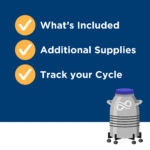At Home Insemination: Your Questions Answered

At home insemination offers a flexible, private, and cost-effective way to grow your family from home. This guide covers the benefits, preparation steps, vial options, the insemination process, and answers to common questions about at home insemination, helping you confidently navigate your fertility journey.

What Exactly Is At Home Insemination?
Let’s clarify what at home insemination is. In simple terms, it’s a method of achieving pregnancy by introducing sperm into the reproductive tract without sexual intercourse, performed in the privacy and comfort of your own home rather than a clinical setting. For many, this approach offers a more relaxed, personal, and often more affordable start to their fertility journey.
Most commonly, at home insemination involves Intracervical Insemination (ICI). This means using a special, needle-free syringe (often part of an at home insemination kit) to place carefully selected donor sperm into the vagina, near the entrance to the uterus (the cervix). From there, the sperm can naturally travel towards the egg for potential fertilization. This mimics the natural process following intercourse but allows individuals and couples who need donor sperm, or those facing certain fertility challenges, to pursue pregnancy on their own terms. Understanding what is at home insemination helps demystify the process.
While less common at home, Intrauterine Insemination (IUI), where sperm is placed directly into the uterus, is typically performed in a clinic due to the need for specially washed sperm and sterile technique to bypass the cervix. Xytex provides both ICI-ready (unwashed) and IUI-ready (washed) vials. For at home insemination, ICI vials are generally used, but using IUI vials for ICI is also perfectly acceptable and may even be preferred by some to potentially reduce cramping.
So, can you do artificial insemination at home? Absolutely! ICI at home insemination is a well-established and viable option for many individuals and couples using donor sperm. It empowers you to take an active role in your conception journey in a familiar environment. Yes, can you do artificial insemination at home is a common question, and the answer for ICI is a resounding yes for many.
Why Choose Home Insemination?
Home insemination appeals to many due to its unique advantages:
- Flexibility: Schedule insemination around your cycle without clinic visits.
- Privacy: Perform the procedure in the comfort of your home, offering an intimate and stress-reducing experience.
- Affordability: Typically, less expensive than in-clinic fertility procedures, broadening accessibility.
- Convenience: No travel is required, which is ideal for busy schedules or those with limited clinic access.
By offering greater control and convenience, home insemination provides an empowering option for many on their fertility journey.
How to Prepare for Your At Home Insemination
Proper preparation is crucial for a smooth at home insemination experience. Before starting, consider these key steps:
- Consult Your Clinician: Discuss your plans with your healthcare provider to confirm at home insemination aligns with your health and fertility plan.
- Select Your Donor: Choose your Xytex sperm donor and complete any necessary account setup and paperwork.
- Budget Accordingly: Factor in the costs involved, including donor sperm vials, shipping, potential storage fees, and supplies like OPKs. We’ll discuss how much is at home insemination in more detail later.
- Emotional Preparation: Take time to prepare emotionally for this significant and personal journey.
With these supplies and proper preparation, you’ll be well-equipped for a confident and stress-free at home insemination experience.
Understanding Vial Options for At Home Insemination
When selecting vials for your at home insemination, you’ll primarily encounter two types from Xytex:
When selecting vials, there are two main types:
- ICI (Unwashed): These vials contain sperm in its more natural state, suitable for intracervical insemination (ICI) at home. The seminal fluid has not been washed away.
- IUI (Washed): These vials contain sperm that has been washed and prepared, typically for intrauterine insemination (IUI) in a clinic. However, IUI vials can also be used for ICI at home insemination and are preferred by some as the washing process removes prostaglandins, potentially reducing the chance of cramping.
Consult with your clinician if you’re unsure which vial type is best for your specific situation, but both are viable for at home insemination via the ICI method.
How to Do At Home Insemination: A Step-by-Step Guide
Embarking on your at home insemination journey is an exciting step. Understanding the process clarifies how does at home insemination work and makes it feel more manageable. This detailed guide explains how to do at home insemination using donor sperm from Xytex, focusing on the ICI method.
Step 1: Timing Your Insemination (When to do At Home Insemination)
Precise timing is crucial for at home insemination. You’ll use ovulation predictor kits (OPKs) to detect the luteinizing hormone (LH) surge, which typically precedes ovulation by 24-36 hours. The optimal time for insemination, or when to do at home insemination, is usually within the 12-24 hours following the first positive OPK result. This timing maximizes the chances of sperm meeting the egg during your fertile window.
Step 2: Thawing the Donor Sperm
Handle the shipping tank and vial with care, following the specific thawing instructions provided by Xytex. Typically, this involves removing the vial from the tank (using gloves if handling the tank components) and allowing it to thaw at room temperature for approximately 25-30 minutes. Do not use warm water or microwaves. Keep the vial upright during thawing. Once thawed, the sperm should be used promptly, ideally within an hour.
Step 3: Preparing and Using Your At Home Insemination Kit
Understanding how to use at home insemination kit components is key. Once the sperm is fully thawed, gently mix the contents by swirling the vial – do not shake vigorously. Carefully open the vial. Uncap your sterile, needle-less syringe (the main part of your basic at home insemination kit from Xytex) and slowly draw the entire contents of the vial into it. Expel any large air bubbles by pointing the syringe upwards and gently tapping it, then slowly pushing the plunger until the sperm reaches the tip. Knowing how to use at home insemination kit components properly ensures correct handling.
Step 4: The Insemination Procedure (ICI)
Find a comfortable position, usually lying on your back with your hips elevated on a pillow. This uses gravity to help the sperm travel towards the cervix. You can perform the at home insemination yourself, or have a partner assist. Gently insert the syringe into the vagina, similar to inserting a tampon. Aim the tip towards the cervix (located at the back of the vagina). Advance the syringe carefully until it feels comfortably deep, but avoid touching the cervix directly if possible. Once positioned, slowly and steadily depress the plunger to deposit the sperm near the cervix. Keep the syringe in place for about 10-15 seconds after emptying it, then slowly withdraw it. This explains the core of how to do at home insemination.
Step 5: Post-Insemination Rest
Remain lying down with your hips elevated for at least 15-30 minutes (some recommend up to an hour) after the at home insemination. This allows time for the sperm to travel. Relax during this period. Avoid getting up, showering, or douching.
Step 6: Follow-Up
Discard the used syringe and vial appropriately. You can resume normal activities after the rest period. This step-by-step explanation clarifies how does at home insemination work in practice, empowering you to proceed confidently.
How Successful Is At Home Insemination?
Understanding potential outcomes is natural. So, how successful is at home insemination, and how effective is at home insemination? Success rates for at home insemination (ICI) using donor sperm vary, but generally, for individuals without underlying fertility issues, the success rate is often cited around 10-15% per menstrual cycle, comparable to natural intercourse for fertile couples.
Achieving pregnancy often takes multiple attempts. Planning for several cycles (potentially 3-6 or more) is realistic. Patience is key when considering how successful is at home insemination.
Factors Influencing Success:
Several elements impact how effective is at home insemination for you:
- Age: Female fertility declines with age, particularly after 35.
- Underlying Fertility Health: Pre-existing conditions can affect success. Consult a healthcare provider.
- Timing Accuracy: Correctly timing the at home insemination with ovulation is critical.
- Sperm Quality: Using high-quality, screened donor sperm from Xytex is vital.
- Procedure Technique: Careful handling and proper technique play a role.
- Number of Inseminations per Cycle: Some perform two inseminations per cycle (requires more vials).
While clinic procedures like IUI or IVF may offer higher rates per cycle, at home insemination remains a viable, effective, and less invasive, more affordable first step for many.
How Much Is At Home Insemination? Cost Considerations
Affordability is a key benefit. But how much is at home insemination?
The cost of home insemination varies but generally ranges from $1,350 to $1,810. This includes the cost of donor sperm, shipping, and a home insemination kit. You can view the exact prices at our sperm bank here.
Costs include:
- Donor Sperm Vials: The primary cost, varying by donor and vial type. Plan for potentially multiple vials/cycles.
- Shipping: There are often fees for specialized tank shipment to your home.
- Storage (Optional): Fees typically apply if long-term vials are stored with most sperm banks.
- Supplies: OPKs, lubricant, etc.
Compared to clinic procedures, at home insemination avoids facility and professional service fees. Review current vial pricing and contact Client Services for detailed shipping/storage costs to budget for your at home insemination journey. Understanding how much at home insemination costs helps in planning.
How to Store Sperm for At Home Insemination
Proper storage maintains viability. Understanding how to store sperm for at home insemination is crucial:
- Shipping Tank (Short-Term): Vials arrive in a liquid nitrogen tank, staying frozen for up to 7 days (check details). Do NOT open or remove vials until ready for thawing/insemination.
- Home Freezers Are Unsuitable: They are not cold enough and will damage sperm. Vials MUST stay in the nitrogen tank.
- Using Within Window: Plan your at home insemination within the tank’s lifespan.
- Long-Term Storage: For vials not used immediately, professional storage at a sperm bank like Xytex is the safest option, preserving viability until needed. This is the recommended method for how to store sperm for at home insemination beyond the shipping window.
Important Considerations for Your At Home Insemination Journey
While at home insemination offers benefits, awareness ensures the best experience:
- Consult Your Healthcare Provider: Strongly recommended before starting at home insemination. They can assess health, offer advice, and provide peace of mind.
- Importance of Screened Donor Sperm: Using sperm from a licensed cryobank like Xytex minimizes health risks and ensures quality.
- Managing Expectations: Pregnancy often takes multiple at home insemination cycles. Patience is important.
- Understanding Vial Types: Know the difference between ICI and IUI vials for informed choices during at home insemination.
- Legal Aspects (Donor Sperm): Using a cryobank provides legal clarity regarding parental rights, a key advantage for at home insemination.
By considering these points, you approach your at home insemination journey with informed confidence.
Common Questions Answered
Here are answers to other frequent questions about at home insemination:
- How long do vials stay frozen in the shipping tank? Typically up to 7 days.
- Can I store vials in my home freezer? No. Vials must remain in the liquid nitrogen tank or be professionally stored at a sperm bank like Xytex.
- What if I’m not ready to use the vials right away? You can arrange for long-term storage with your sperm bank. At Xytex, we offer long term sperm storage options as well. (fees apply).
- Do I need medical approval for at home insemination? Generally no, but New York state requires a physician’s authorization for home shipment.
- Is at home insemination available worldwide? Currently, Xytex offers home shipments only within the U.S. due to regulations.
Home Insemination: Your Journey, Our Commitment
At home insemination offers a flexible, private, and empowering way to take control of your fertility journey. Preparing thoroughly, choosing the right vial, and timing insemination carefully create a strong foundation for success.
At Xytex, we are committed to supporting you every step of the way. If you need guidance, reach out to our professionals with your questions. Let’s navigate this path together and bring you closer to achieving your dream of parenthood.
Watch more of our videos on our YouTube channel.




